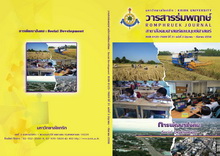ความสัมพันธ์ระหว่างการใช้ที่ดินจากดัชนีพืชพรรณกับวิถีชีวิตครัวเรือนในบ้านควนทราย ตำบลลำทับ อำเภอลำทับ จังหวัดกระบี่
Main Article Content
Abstract
The Relationship Between Land Use as Categorized by Vegetation Index Method with Household Livelihood in Khuan Sai Village Lam Thap Subdistrict Lam Thap District Krabi Province
The application of vegetation index for exploring land use and household livelihood in Khuan Sai village, Lam Thap subdistrict, Lam Thap district, Krabi province was aimed to investigate the household livelihood in term of economics, social and environment all aspects, and also to analyze the relationship between land use types as categorized by vegetation index and communal livelihood in Khuan Sai village.
Research methodologies were composed of two parts. Part one was the participatory study on the communal livelihood in term of economics, social and environmental situations. The household livelihood was analyzed based on the usage of five assets namely human assets, social cultural and political assets, physical assets, financial assets, and natural assets. Part two was carried out by analyzing the effect of land use on communal livelihood by using radar chart method. The acquired data were then analyzed and interpreted based on the five assets, presenting the results in the form of pentagon graph, and thus advocating the trend of land use options.
The results obtained from the supervised minimum distance of vegetation index NDVI showed that there were 2,741 rai of rubber planting area, 1,130.78 rai of oil palm planting area, 8.98 rai of coffee planting area, 187.09 rai of mixed crops planting area, 173.14 rai of forest area, 29.47 rai of surface water area, and 363.46 rai of abandoned area. The relationship between the household livelihood of rubber, oil palm and rubber-oil palm growers with the natural asset were the highest, followed respectively by the social cultural and political asset, physical asset, financial asset and human asset. For this study, the results attained help advocated the trend of land use options for rubber and oil palm cropping by aiming on the strategy towards the sustainable agro-industry development and life quality of the people living in the area.
Article Details
Every article published in the Romphruek Journal of the Humanities and Social Sciences is the opinion and point of view of the authors. Thery're not the viewpoint of Krirk University or the editored department. Any part or all of the articles for pablication must be clearly cited.


